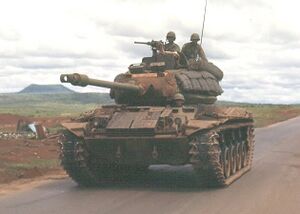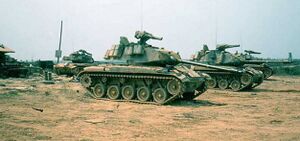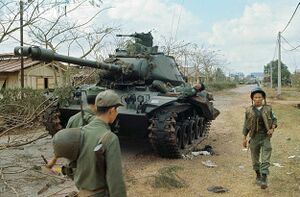Roland Land Systems Mastiff: Difference between revisions
No edit summary |
No edit summary |
||
| Line 49: | Line 49: | ||
The M305 Mastiff has a very distinctive, well sloped glacis plate with a horizontal top, and may also be readily identified by its large exhaust pipes on each side of the upper hull rear.[2] Both turret sides are vertical and slightly sloped. Other identifying features on the turret include the bustle and stowage box at the rear, the commander's cupola to the right, and the muzzle brake with fume extractor on the main armament. | The M305 Mastiff has a very distinctive, well sloped glacis plate with a horizontal top, and may also be readily identified by its large exhaust pipes on each side of the upper hull rear.[2] Both turret sides are vertical and slightly sloped. Other identifying features on the turret include the bustle and stowage box at the rear, the commander's cupola to the right, and the muzzle brake with fume extractor on the main armament. | ||
[[File:M305MBT.jpg|thumb|left|A M305A3 equipped with an Ostlander {{wpl|BGM-71 TOW|Karlsbranchen Panzerschreck 70}} ATGM launcher operated by the commander.]] | |||
The M305A1, A2 and A3 are all equipped with a 76 mm rifled cannon designed and produced by [[Karlsbranchen]] of [[Ostlichtor]]. Standard ammunition included fixed {{wpl|Shell (projectile)|high explosive}} (HE), {{wpl|Armour-piercing ammunition|armor piercing}} (AP), or {{wpl|Shell (projectile)|high velocity armor piercing}} (HVAP) ammunition, with the HVAP rounds being replaced by {{wpl|armour-piercing fin-stabilized discarding sabot}} (APFSDS) ammunition. Total combat load of 65 rounds for the main gun. Starting with the M305A3, the commanders machinegun could be replaced with a pintle mounted {{wpl|BGM-71 TOW|Karlsbranchen Panzerschreck 70}} {{wpl|Wire-guided missile|wire-guided}} {{wpl|anti-tank guided missile}}. | |||
In the 1980's, an extensive upgrade program was initiated for the M305, resulting in the M305A4 version equipped with a 90 mm cannon also designed and produced by Karlsbranchen. The M-1981 90 mm cannon provided similar performance to contemporary 105 mm cannons in service with various nations. The main guns round was reduced to 45 rounds. Again, in 1999, a second update for the M305s main armaments was accepted into service. The M305A6 received the ALA-82, a 105 mm cannon designed and produced by [[VT Cinética]], which was originally produced for the [[Mako Light Tank]]. | |||
Secondary armaments' initially included two .30 caliber {{wpl|M1919 Browning machine gun|Bennett M-2}} machine guns, one mounted coaxial to the main cannon and the second on a roof pintle mount. In the 1970's both guns were replaced with versions of the {{wpl|Heckler & Koch HK21|Blitz & Keckler M-3}}, the coaxial gun retaining its .30 caliber chambering, and the commanders gun being replaced with a {{wpl|Heckler & Koch HK21#HK25|Blitz & Keckler M-4}} heavy machine gun chambered in {{wpl|13.2×92mmSR|13.2×92 mm}}. | Secondary armaments' initially included two .30 caliber {{wpl|M1919 Browning machine gun|Bennett M-2}} machine guns, one mounted coaxial to the main cannon and the second on a roof pintle mount. In the 1970's both guns were replaced with versions of the {{wpl|Heckler & Koch HK21|Blitz & Keckler M-3}}, the coaxial gun retaining its .30 caliber chambering, and the commanders gun being replaced with a {{wpl|Heckler & Koch HK21#HK25|Blitz & Keckler M-4}} heavy machine gun chambered in {{wpl|13.2×92mmSR|13.2×92 mm}}. | ||
Revision as of 21:20, 22 July 2024
This article is incomplete because it is pending further input from participants, or it is a work-in-progress by one author. Please comment on this article's talk page to share your input, comments and questions. Note: To contribute to this article, you may need to seek help from the author(s) of this page. |
| Roland Land Systems Mastiff | |
|---|---|
 M305 Mastiff of the 2nd Armored Regiment, 2nd Brigade "Speartip" during training exercises circa 1974 | |
| Type | Main battle tank |
| Place of origin | |
| Service history | |
| In service | 1951 - present |
| Used by | See Users |
| Production history | |
| Designer | Roland Land Systems |
| Designed | 1944 |
| Manufacturer | Roland Land Systems |
| Produced | 1951 - 1969 1988 - 1997 |
| Variants | See variants |
| Specifications | |
| Weight | 23.49 tonnes |
| Length | 5.81 m (19 ft 1 in) |
| Width | 3.19 m (10 ft 6 in) |
| Height | 2.72 m (8 ft 11 in) |
| Passengers | 4 (commander, gunner, loader, driver) |
| Armor | 25.4 mm (1.00 in) turret front 25 mm (0.98 in) turret sides and rear 12.7 mm (0.50 in) turret top 31.7 mm (1.25 in) at 30° hull upper glacis plate 25.4 mm (1.00 in) at 45° hull lower glacis plate 19 mm (0.75 in) hull rear 9.25 mm (0.364 in) hull floor |
Main armament | Karlsbranchen M-1947 76 mm tank cannon (65 rounds) Karlsbranchen M-1981 90 mm tank cannon (45 rounds) VT Cinética ALA-82 105mm L/58 rifled cannon (23 rounds) |
Secondary armament | Blitz & Keckler M-3 coaxial machine gun (5,000 rounds), Blitz & Keckler M-4 roof-mounted machine gun (2,175 rounds) |
| Engine | SMC HVE-895-3 six-cylinder air-cooled gasoline 500 bhp (370 kW) |
| Power/weight | 21.2 hp (15.8 kW) |
| Suspension | Torsion bar |
| Ground clearance | 0.45 m (1.5 ft) |
| Fuel capacity | 530 L (140 US gal) |
Operational range | 161 km (100 mi) |
| Speed | 72.4 km/h (45.0 mph) |
The Roland Land Systems Mastiff, in service with the Shenandoahan Army National Guard as the M305 Main Battle Tank, is a armored vehicle intended for close infantry support role, reconnaissance and rapid airborne deployments. The M305 has been in service since 1951 and has been upgraded and modernized several times. The current service variant of th M305 is the M305A7.
Development
Description
The hull of the M305 Mastiff is of welded steel construction, with the driving compartment located at the front of the tank and to the left. This may be accessed through the hull by a single piece hatch cover opening to the right. When the hatch is closed, the tank is navigated by three driving periscopes mounted forward of the driver's position and one to the left. An emergency escape hatch is situated beneath the driver's seat.
The M305's engine, a SMC HVE-895-3 six-cylinder air-cooled gasoline engine, is located towards the rear of the hull and is insulated from the crew by a fireproof bulkhead.
Standard M305 Mastiff turrets are of cast and welded steel construction and fitted with a turret basket. The crew commander and gunner are seated to the right and a loader seated to the left. Turret rotation is assisted by hydraulic/electrical drives and takes approximately ten seconds to traverse a full 360°. Crew commanders have a day periscope and a turret cupola with five vision blocks for observation; this is also provided with a hinged hatch cover opening forwards. In newer models, both night vision and thermal sights are provided for the commander and gunner. Both the loader and gunner are also provided with periscopes. In some models, there is an additional stowage basket welded to the rear of the turret, and a dome-shaped ventilator on the turret roof.
The M305 Mastiff has a very distinctive, well sloped glacis plate with a horizontal top, and may also be readily identified by its large exhaust pipes on each side of the upper hull rear.[2] Both turret sides are vertical and slightly sloped. Other identifying features on the turret include the bustle and stowage box at the rear, the commander's cupola to the right, and the muzzle brake with fume extractor on the main armament.

The M305A1, A2 and A3 are all equipped with a 76 mm rifled cannon designed and produced by Karlsbranchen of Ostlichtor. Standard ammunition included fixed high explosive (HE), armor piercing (AP), or high velocity armor piercing (HVAP) ammunition, with the HVAP rounds being replaced by armour-piercing fin-stabilized discarding sabot (APFSDS) ammunition. Total combat load of 65 rounds for the main gun. Starting with the M305A3, the commanders machinegun could be replaced with a pintle mounted Karlsbranchen Panzerschreck 70 wire-guided anti-tank guided missile.
In the 1980's, an extensive upgrade program was initiated for the M305, resulting in the M305A4 version equipped with a 90 mm cannon also designed and produced by Karlsbranchen. The M-1981 90 mm cannon provided similar performance to contemporary 105 mm cannons in service with various nations. The main guns round was reduced to 45 rounds. Again, in 1999, a second update for the M305s main armaments was accepted into service. The M305A6 received the ALA-82, a 105 mm cannon designed and produced by VT Cinética, which was originally produced for the Mako Light Tank.
Secondary armaments' initially included two .30 caliber Bennett M-2 machine guns, one mounted coaxial to the main cannon and the second on a roof pintle mount. In the 1970's both guns were replaced with versions of the Blitz & Keckler M-3, the coaxial gun retaining its .30 caliber chambering, and the commanders gun being replaced with a Blitz & Keckler M-4 heavy machine gun chambered in 13.2×92 mm.
All versions and variants of the M305 Mastiff utilize a torsion bar suspension, which supports five road wheels with the drive sprocket at the rear and idler towards the front, and three track return rollers, with the first, second, and fifth road wheel stations having hydraulic shock absorbers.
Although the M305 Mastiff is not considered amphibious, it was designed for fording up to 1.016 meters of water without preparation, and up to 2.44 meters of water with preparation.
Operational History
